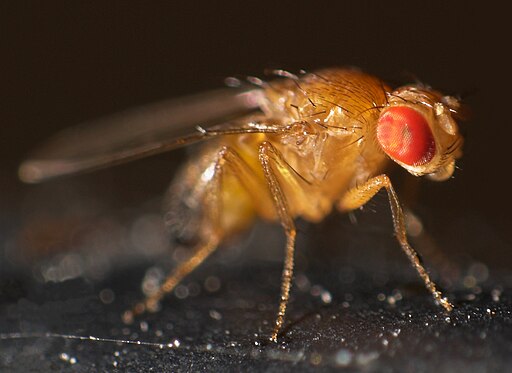Fruit flies, together with other non-mammalian species like nematode worms and zebrafish have emerged as indispensable allies to autism research, writes Dr. Mohammad Farhan.
In just two decades, the realm of genetic exploration has undergone a profound transformation, driven by the emergence of genome-wide association studies (GWAS) and whole genome/exome sequencing (WGS/WES).
These methodologies have unveiled a sweeping vista of genetic risk factors intertwined with a wide spectrum of human disorders. Yet, amidst the bounty of these revelations, a fundamental challenge persists—the translation of genetic insights into actionable clinical knowledge.
Despite notable success in identifying disease susceptibility loci, the translation of these findings into actionable clinical insights has been limited, with few loci undergoing successful functional validation. Consequently, a significant knowledge gap persists surrounding the biological context of many identified risk loci.
In the intricate landscape of neurological disorders, prominently autism, rapid strides in next-generation sequencing have ushered an era of unparalleled genetic revelations. This torrent of data has brought forth a multitude of genes and variants implicated in these disorders.
Biology nevertheless maintains the potential to surprise, with even the weakest connections to diseases observed through bioinformatics potentially laying the foundations for research initiatives. What hasn’t changed is that research into the causes of diseases requires complex experimentation in laboratory settings.
It is here that Drosophila melanogaster (fruit flies), together with other non-mammalian species like Caenorhabditis elegans (nematode worms) and Danio rerio (zebrafish), have emerged as indispensable allies.
While rats and mice remain important to relevant scientific research activities, fruit flies offer a distinct advantage over their mammalian counterparts in that they provide an agile cost-effective evaluation of gene variant effects in behaviour-rich organisms.
Recent breakthroughs leveraging these models have accelerated genetic disease diagnoses and illuminated potential therapeutic avenues. They have not just unveiled the secrets of rare diseases, but also shed light upon the broader tapestry of disease mechanisms and gene functionalities, laying paths for future exploration in the process.
With a versatile toolkit and expansive repository of gene manipulation resources at their disposal, fruit flies are moving to the forefront of efforts to unravel the intricate biology of human diseases. Drosophila-based studies present an unparalleled platform offering the means to conduct experiments on a grand scale, armed with an array of easily available genetic tools.
Despite the innate disparities between fruit flies and humans, a striking convergence resonates across physiological, molecular, and genetic realms. Fruit flies stand as a powerful surrogate, with a complete brain housing diverse neuronal cell types. Interestingly, around 75% of genes implicated in autism spectrum disorder (ASD) find their counterparts conserved in fruit flies.
The biological processes underpinning ASD show remarkable conservation in fruit flies at molecular, cellular, and synaptic levels.
Notably, an array of ASD-related phenotypes find a counterpart in fruit flies, including core behaviours like learning defects, repetitive activities, and social interactions. The same is also true of many comorbid behaviours such as anxiety, sleep disturbances, epilepsy, eating disorders, as well as neurodevelopmental anomalies like micro or macrocephaly and synaptic density.
In this intricate landscape, fruit flies emerge as a powerful tool for unraveling the complexity of ASD.
In the unique context of Qatar, where prevalence of ASD slightly eclipses global estimates and genetics contribute to over 83% of familial cases, the challenges in identifying risk genes and comprehending their pathological mechanisms assume multifaceted dimensions.
Notably, the absence of a rodent facility for neurogenetics and behavioural research adds an extra layer of complexity to this quest. Amidst these challenges, the fruit fly emerges as an invaluable ally.
At the helm of this transformative pursuit is a global consortium of scientists coalescing around the laboratory of Prof. Hugo Bellen at Baylor College of Medicine.
United in their pursuit of validating genetic variants and unraveling disease mechanisms, their collective efforts have unveiled the genetic origins of an impressive 35 human diseases within a mere five years. This monumental achievement has cast a luminous spotlight on intricate disease mechanisms ushering in new horizons for therapeutic interventions.
Thanks in no small part to fruit flies, they have also propelled the realm of medical science into uncharted territories and enriched lives along the way.
For its part, Hamad Bin Khalifa University’s (HBKU) College of Health & Life Sciences (CHLS) has also pioneered the use of fruit flies-based models in research covering ASD and other neurodevelopmental disorders.
With recent entries in high-impact journals like the Journal of Neurodevelopmental Disorders and PLOS Biology, the College’s work epitomises precision in modelling and understanding molecular mechanisms associated with autism.
Directed at the Single Stranded Binding Protein 3 (SSBP3/Ssdp) gene, previously implicated in neurodevelopmental disorders and autism, researchers leverage the might of fruit flies to unveil developmental, morphological, molecular, cellular, and behavioural deficits that resonate with challenges posed by ASD. Rooted in the strengths of fruit flies and amplified by genetic and molecular biology tools, they also unveil hitherto unseen molecular mechanisms mediated by SSBP3 within the Drosophila brain.
These endeavours collectively underscore the vast insights that increasingly emerge from even the humblest of organisms, such as fruit flies.
They also offer a rich tapestry of knowledge to comprehend fundamental human diseases and pave the path toward intervention strategies and promising avenues for future research. Drug screening is a case in point, with researchers at the University of Massachusetts’ Center for Personalized Cancer Therapeutics currently using Drosophila to test combinations of FDA-approved drugs and their ability to reduce disease symptoms.
Scientists engaged in autism research will undoubtedly be observing these experiments with great interest, particularly if they reveal new opportunities to utilise fruit flies in their work.
Dr. Mohammad Farhan is an assistant professor at Hamad Bin Khalifa University’s College of Health and Life Sciences.
This piece has been submitted by HBKU’s Communications Directorate on behalf of its author. The thoughts and views expressed are the author’s own and do not necessarily reflect an official University stance.
The views and opinions expressed in this article are those of the authors and do not necessarily reflect the official policy or position of Doha News, its editorial board or staff.







